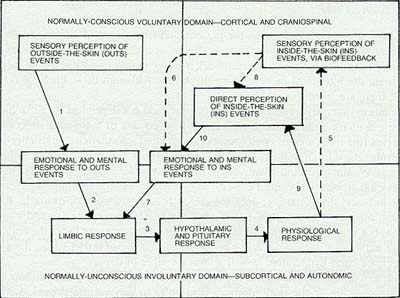Biofeedback is generally defined as the presentation to a person of ongoing biological information, such as heart rate, usually by means of meters, lights, or auditory signals, so that he or she can become aware of inside-the-skin behaviors. Biofeedback training means using the information in learning how to self-regulate the biological process being displayed. Although these kinds of definitions are most often used, there are some qualifications.
If one wants to make self-regulation truly voluntary and not dependent on a machine, it is necessary to be conscious of what the feedback represents. Biofeedback of autonomic processes presents to the cerebral cortex (the main area of consciousness in humans) information that usually is fed back almost entirely to subcortical brain centers. Blood flow in the various parts of the body and in various organs, for instance, is continuously and sensitively monitored by an internal feedback system that sends signals to an unconscious subcortical control center, the hypothalamus, and not until large temperature changes occur (due to blood flow changes) does the cortex become aware. For example, the average person without training cannot tell within 5.0°F what the hand temperature is, and cannot control hand temperature, but when a great deal of hand-temperature information is fed to the cortex, by the use of a temperature indicator that provides a just noticeable difference of 0.01°F, then the average person can learn to increase hand temperature at will within a couple of days.
Our primitive ancestors, with a life expectancy of perhaps twenty years, did not have much use or need for conscious inside-the-skin information in order to survive in a struggle with outside-the-skin nature, but our present-day problems are almost the reverse of theirs. Our stress is not from the physical world as much as from the psychological world, and feedback of inside-the-skin information is useful for control of inside-the-skin stress responses. In this regard, some of our problems with stress seem to be tied to the fact that we still have the caveman and cavewoman bodies of our ancestors. Many anthropologists point out that no significant changes have taken place in the gene pool for ten thousand years-some say fifty thousand-and that we still handle most stress with our "fight or flight" brain, the limbic system, sometimes called the visceral brain or the emotional brain.
The Biofeedback Society of America (founded in 1969 as the Biofeedback Research Society) invented the modern terminology in the field, but the earliest date for the use of biofeedback was at least as long ago as the development of yoga for control of certain autonomic processes of the body. In learning to control blood flow in the limbs, for instance, the color of the skin provided visual feedback as an indication of success. This is definitely biofeedback; information that was usually unconscious became detectable to the eye, and was fed to the cortex via the optic nerve. Such a feedback system was relatively inefficient because of low sensitivity, but nowadays sensitive electronic thermometers make learning easy.

The fact that it is quite easy to learn with biofeedback to control certain autonomic functions raises a question: How does biofeedback work? As a possible answer, consider figure 1. Sensory perception of outside-the-skin (OUTS) events, stressful or otherwise (upper left box), leads to a physiological response along arrows 1 to 4. If the physiological response is "picked up" and fed back (arrow 5) to a person who attempts to control inside-the-skin (INS) behavior, through imagining and visualizing a desired change, then arrows 6 and 7 come into being, resulting in a "new" limbic (emotional) response. This response in turn makes a change in ''signals" transmitted along arrows 3 and 4, modifying the original physiological response. A cybernetic loop is thus completed, and the dynamic equilibrium (homeostasis) of the system can be brought under voluntary control. Biofeedback practice, acting in the opposite way to drugs, increases a person's sensitivity to INS events, and eventually arrow 8 develops, followed by the development of arrows 9 and 10. External feedback is then unnecessary, because direct perception of INS events becomes adequate for maintaining self-regulation skills. Physiological self-control through classical yoga develops along the route of arrows 7-3-4-9-10-7, but for control of specific physiological and psychosomatic problems biofeedback training seems more efficient.
The main scientific question about biofeedback, and yoga too, seems to be, How does visualization, or imagination of a change in physiological processes, get converted into an actual physiological process? Along the same vein: How does an "organ-specific formula" (a phrase from J.H. Schultz's Autogenic Training) make a change in an organ? And again, how do John Basmajian's and Bernard Engel's biofeedback training methods, respectively, lead to control of firing in single motor nerve cells and in specific sections of the heart? The answer may be, of course, that mind and body are made of the same basic substance, and that if we can regulate mind, we can regulate body. Whatever the case, it is clear that much interesting research remains to be done.
(From Holistic Dimensions in Healing, Leslie Kaslof, Ed.)